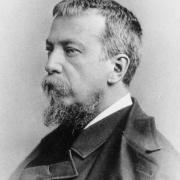Phantom Limb Pain and the Civil War
Though the phenomenon of phantom limb pain had been recorded long before the Civil War, it was Silas Weir Mitchell (pictured at left), a Philadelphia physician specializing in nerve injuries during the Civil War, who coined the term. Phantom limb pain, or PLP, occurs when a patient feels pain in an arm or leg that has been amputated. Mitchell studied PLP (or sensory hallucinations, as he also called them) in depth at the Turner’s Lane hospital in Philadelphia, dubbed the Stump Hospital because it focused on caring for amputees. [[{"type":"media", "view_mode":"media_large", "fid":"1199", "attributes":{"class":"media-image alignleft", "typeof":"foaf:Image", "style":"", "width":"194", "height":"300", "alt":"Widow cover 3 hi res"}}]]Since one of my characters in Widow of Gettysburg became an amputee, the following helped inform my story and character development.
What Mitchell Found
Almost every amputee at Turner’s Lane Hospital experienced PLP.
Most of them came out of anesthesia feeling the presence of the amputated limb.
Those who did not immediately feel PLP usually felt it within three weeks.
Usually, the patients felt the missing hand/foot but not the section of limb directly beyond the stump.
Mitchell wrote: “The patients describe themselves as knowing that they have a hand which is connected to a stump, and feel able to move it, but of the rest of the limb they are unconscious, and the subjective sensations which are so common are always referred to the hand or foot, and rarely to the continuity of the member.”
In about one-third of the leg cases, and in one-half of the arm amputations, the patient felt that the foot or hand is nearer to the trunk than the extremity of the limb.
The type of pain could be burning, itching, stabbing, or cramping.
Missing legs usually felt as though they are hanging straight down, while missing arms felt as though they were bent at the elbow or locked in the last position they were in prior to the operation.
Treatment of water dressings on the stump helped with burning sensations in some cases, but most efforts to relieve PLP were ineffectual.
Amputee veterans wrote to Mitchell decades after their operations and shared that in their dreams, they had all their limbs perfectly whole.
[[{"type":"media", "view_mode":"media_large", "fid":"1200", "attributes":{"class":"media-image size-full wp-image-2953", "typeof":"foaf:Image", "style":"", "width":"529", "height":"640", "alt":"Amputees like this one would have dealt with phantom limb pain (PLP)."}}]] Amputees like this one would have dealt with phantom limb pain (PLP).
What We Know Today The study of PLP continues with today’s generation of amputee veterans. Most contemporary studies confirm what Mitchell found, but add to it some new information. Most recent studies report PLP at rates of 50% to 80%. A few of these are in constant pain, but for most, the episodes can last a few seconds or one to two hours. Since the beginning of the conflicts in Iraq and Afghanistan more than 1000 amputees have been treated at Walter Reed Army Medical Center in Washington, DC. Almost all experience PLP, either within the first 24 hours of amputation, or within two weeks. The following insight comes from an article in a 2010 issue of The Neurologist:
“As part of routine treatment efforts, the patients are asked to describe their experience with phantom sensation and phantom pain. There have been a plethora of responses regarding the onset, duration, description, and location of phantom sensations and phantom pains from those queried. Furthermore, some explain they have volitional control over their phantom, and can move their phantom at will, while others report their phantoms being fixed in a specific position. Some even report the inability to make movements with the phantom, despite the presence of a strong sensation or pain emanating from their residual limb. For example, one service member reported that his phantom hand was in a distinct position: he felt he was pulling the trigger on his rifle with his index finger, and was unable to move his hand to a different position. He also felt cramping pains in his hand muscles. Another service member, a bilateral, above knee amputee, described the feeling of heavy legs, asserting that the feeling was similar to weights attached to his calf muscles. He also described that it felt as though his combat boots were on too tightly.”
There are multiple theories as to the cause of PLP, all of which can be read in this online article. The most successful treatments have been with opioids and mirror therapy, the latter considered the most promising treatment plan. In this treatment, the patient views the reflection of their intact limb moving in a mirror placed between the arms or legs while simultaneously moving the phantom hand or foot in a manner similar to what they are observing. The virtual limb in the mirror appears to be the missing limb. Patients have reported a relief of cramping and “frozen limb” phantom pains as a result of even one session with the mirror. In one study in which patients used mirror therapy for 15 minutes each weekday for four weeks, significant decreases in pain were reported. More about mirror therapy can also be found in the online article hyperlinked above. For further reading: Mitchell, Silas Weir. The Case of George Dedlow. (fictional account of quad amputee) New York: The Century Co., 1900. Read it online at Google Books here, and begin on page 115. http://bit.ly/ZixtJd Gunshot Wounds and other Injuries of Nerves. Philadelphia: J.B. Lippincott, & Co., 1864. Read it online at Google Books here: http://bit.ly/17hhuvf

